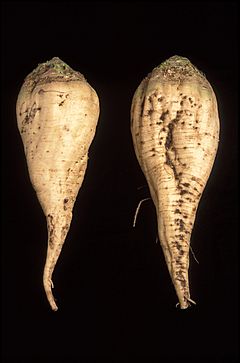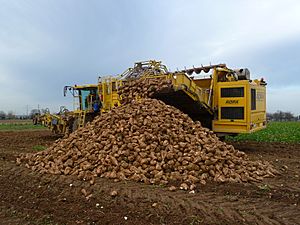Sugar beet facts for kids
Quick facts for kids Sugar beet |
|
|---|---|
 |
|
| Two sugar beets - the one on the left has been selectively bred to be smoother than the traditional beet, so that it traps less soil. | |
| Scientific classification | |
| Kingdom: | |
| Division: | |
| Class: | |
| Order: | |
| Family: | |
| Genus: |
Beta
|
| Species: |
B. vulgaris
|
| Binomial name | |
| Beta vulgaris |
|
The sugar beet is a plant grown for its large root. This root holds a lot of sucrose, which is the same kind of sugar you use at home! Farmers grow sugar beets to make sugar. This plant is related to Chard, another leafy vegetable.
The countries that grow the most sugar beets are the European Union, the United States, and Russia. About 30% of all the sugar made in the world comes from sugar beets.
Contents
What Does a Sugar Beet Look Like?
A sugar beet has a white, cone-shaped root that grows deep into the ground. This root is where the plant stores its sugar. Above ground, the plant has a bunch of green leaves that grow in a circle.
The leaves use photosynthesis to make sugar from sunlight. This sugar then travels down and gets stored in the root. The root is mostly water (about 75%), with around 20% sugar and 5% pulp. The amount of sugar can change, usually between 12% and 21%, depending on the type of beet and how it's grown.
The sugar is the most important part of the sugar beet for farmers. The pulp, which is the leftover plant material, is used to feed animals. Other parts of the beet, like molasses, also add value to the harvest.
Sugar beets grow best in temperate (mild) climates. This is different from sugarcane, which needs hot, tropical weather. A single sugar beet usually weighs between 0.5 and 1 kg (1.1 and 2.2 lb). Its bright green leaves can grow up to 35 cm (14 in) tall.
Growing Sugar Beets
Growing sugar beets successfully needs the right soil and climate. The soil should have many nutrients and be able to hold a lot of moisture. It's best if the ground is fairly flat and drains water well.
A sandy loam soil is ideal. This is a mix of organic matter, clay, and sand. The soil needs to be deep, about 12 to 15 inches (30.5 to 38.1 cm), so the roots can grow long and strong.
The weather is also very important. A temperature between 15 to 21 °C (59.0 to 69.8 °F) during the growing months is best. Sugar beets also need plenty of sunshine, but not too much intense heat. In places like Colorado and Utah, where days are warm but nights are cool, sugar beets grow very well.
Farmers prepare the land carefully by ploughing deeply. This helps the roots grow down easily and get nutrients from the soil. Sugar beets use up nutrients in the soil quickly. So, farmers often use crop rotation. This means they grow beets in the same field only every third year, planting other crops like peas or grain in between.
Harvesting Sugar Beets
In most mild climates, sugar beets are planted in the spring and harvested in the autumn. In warmer places like California, they are planted in autumn and harvested in spring. Recently, new types of sugar beet have been developed that can grow in tropical areas too.
In the past, growing and harvesting sugar beets needed a lot of human effort. Workers had to thin the plants by hand and then harvest them using special tools. It was very hard work!
Today, machines do most of the work. Machines plant the seeds and spray herbicides to control weeds. When it's time to harvest, a special machine called a beet harvester lifts the roots from the ground. It also cleans off extra soil and chops off the leaves and top part of the root.
The harvester can pick up many rows of beets at once. It then dumps the beets into trucks, which take them to the factory. If the beets are not processed right away, they are stored in large piles called "clamps." These piles are covered to protect the beets from the weather.
The time when beets are harvested and processed is called "the campaign." Factories run 24 hours a day during this time to turn the beets into sugar.
Images for kids
See also
 In Spanish: Remolacha azucarera para niños
In Spanish: Remolacha azucarera para niños












